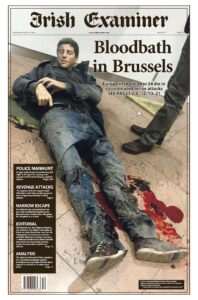It seems almost a lifetime ago, but in March 2016 Belgium was hit by bombings in Brussels Airport and on the metro. More than 35 people died, including three suicide bombers, while hundreds were injured. The trial only opened in December.
We were going big on it. Europe was already on alert after the Paris attacks and the Bataclan theatre, and there was a definite sense of edginess. We knew Irish people had been in the area in Brussels, which at the end of the day hosts the headquarters of the EU. I remember coming into work with half a concept of a page in mind. Or a vague idea anyway. Some of the details of the attacks had been out for a few hours; it was clear even then that there had been significant loss of life and a huge number of injuries. I wanted to do something that conveyed the horror of it, but also the human cost.
One of the first things I did after starting work was trawl through all the images we had available. I don’t remember how many there were. Presumably dozens. I knew I was looking for something particular. I just didn’t know exactly what it was, until I saw the picture I ended up using.
This was the very first time I asked to drop the ad off the front page. I mocked up a concept to show the editor at the time, Tim Vaughan, because I knew it would be easier to make that argument if he had something in his hand as opposed to words coming out of my mouth. The image was powerful but not powerful enough if it had to accommodate a 20cm, three-column ad. Or not as powerful as it could be anyway.
At the time I wasn’t even the main front page person (I had done plenty, though) but Tim, to his credit, understood what I was trying to achieve and made the arrangements to go ad free. The result is what you see above.


